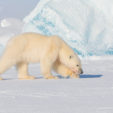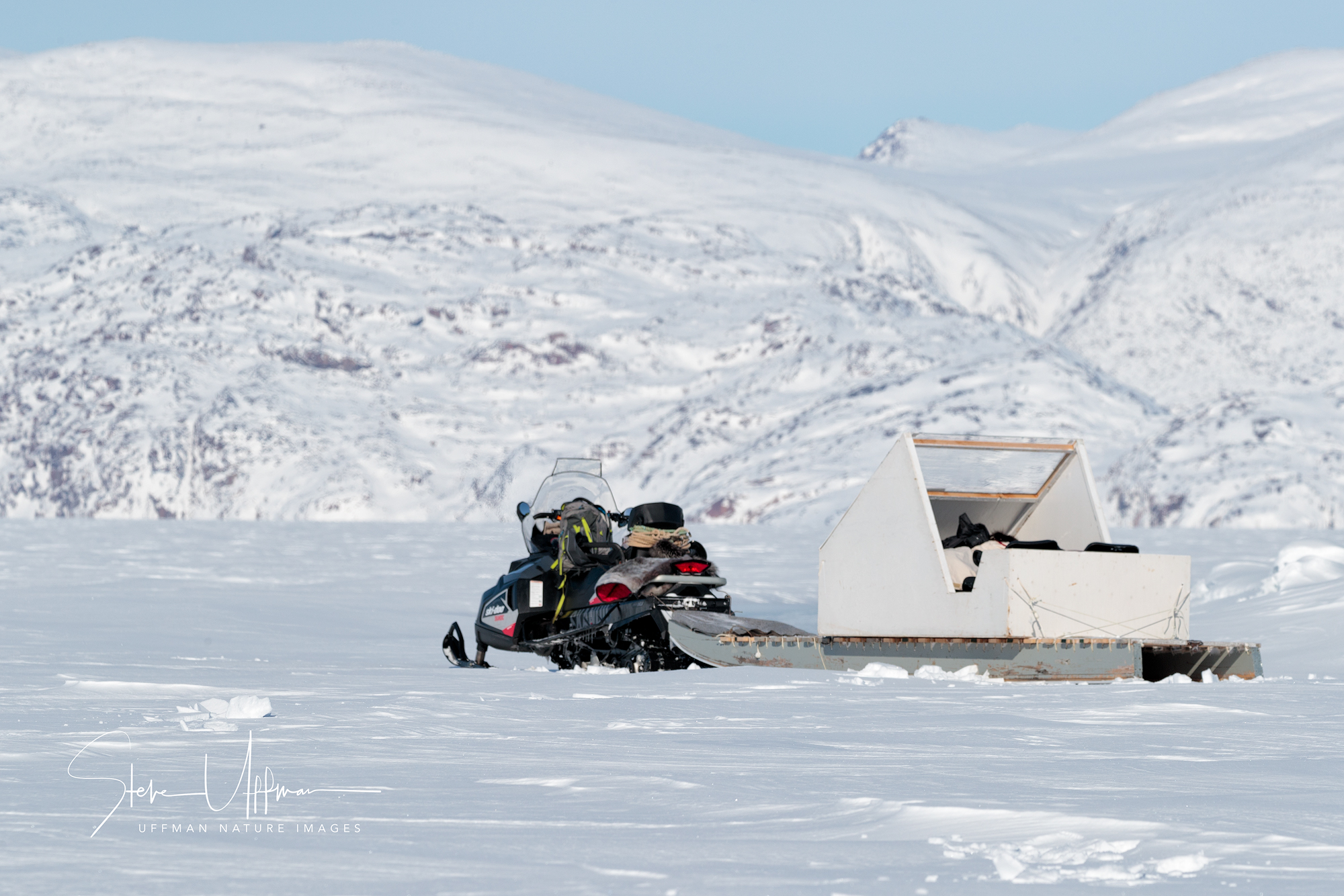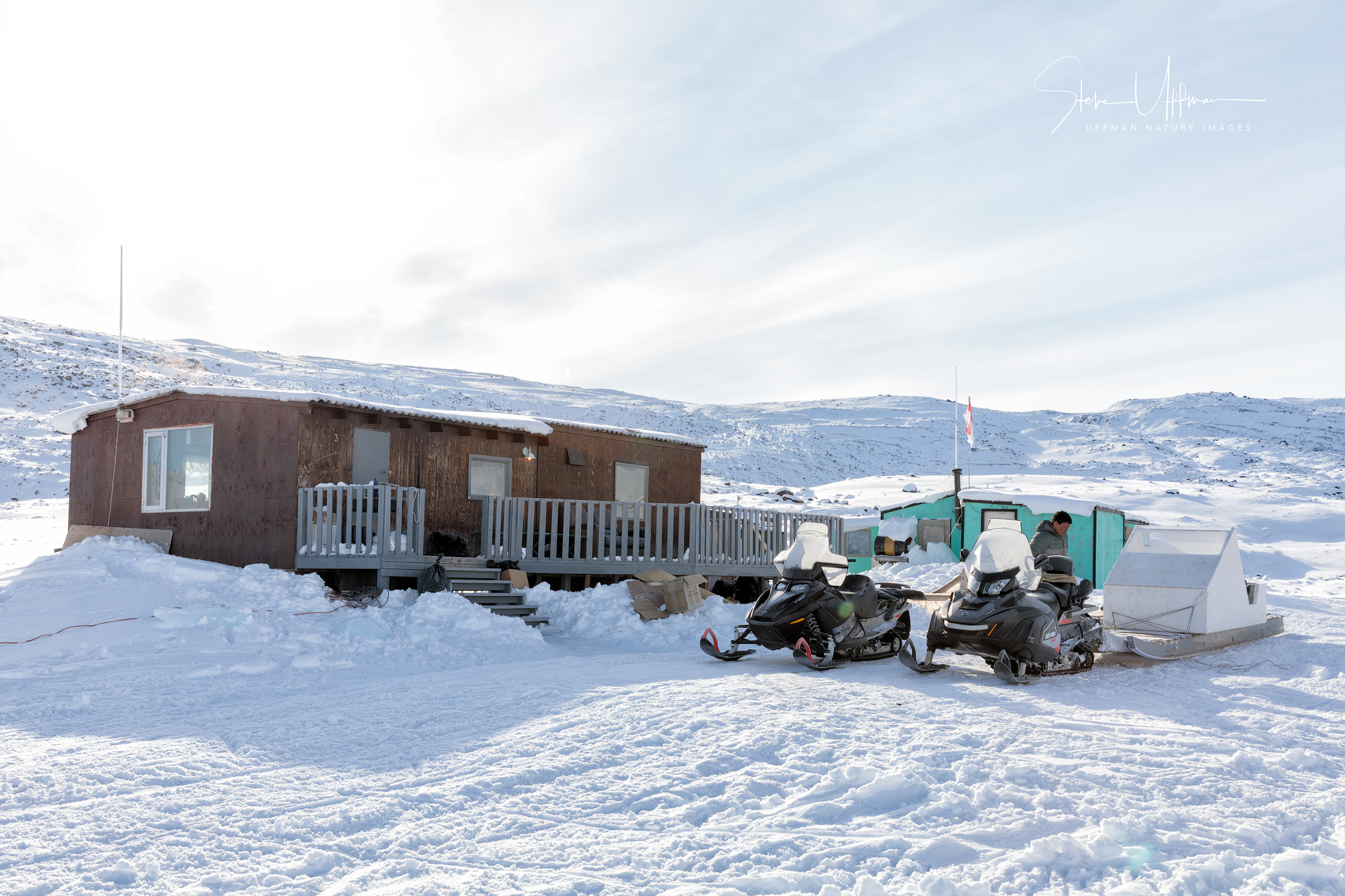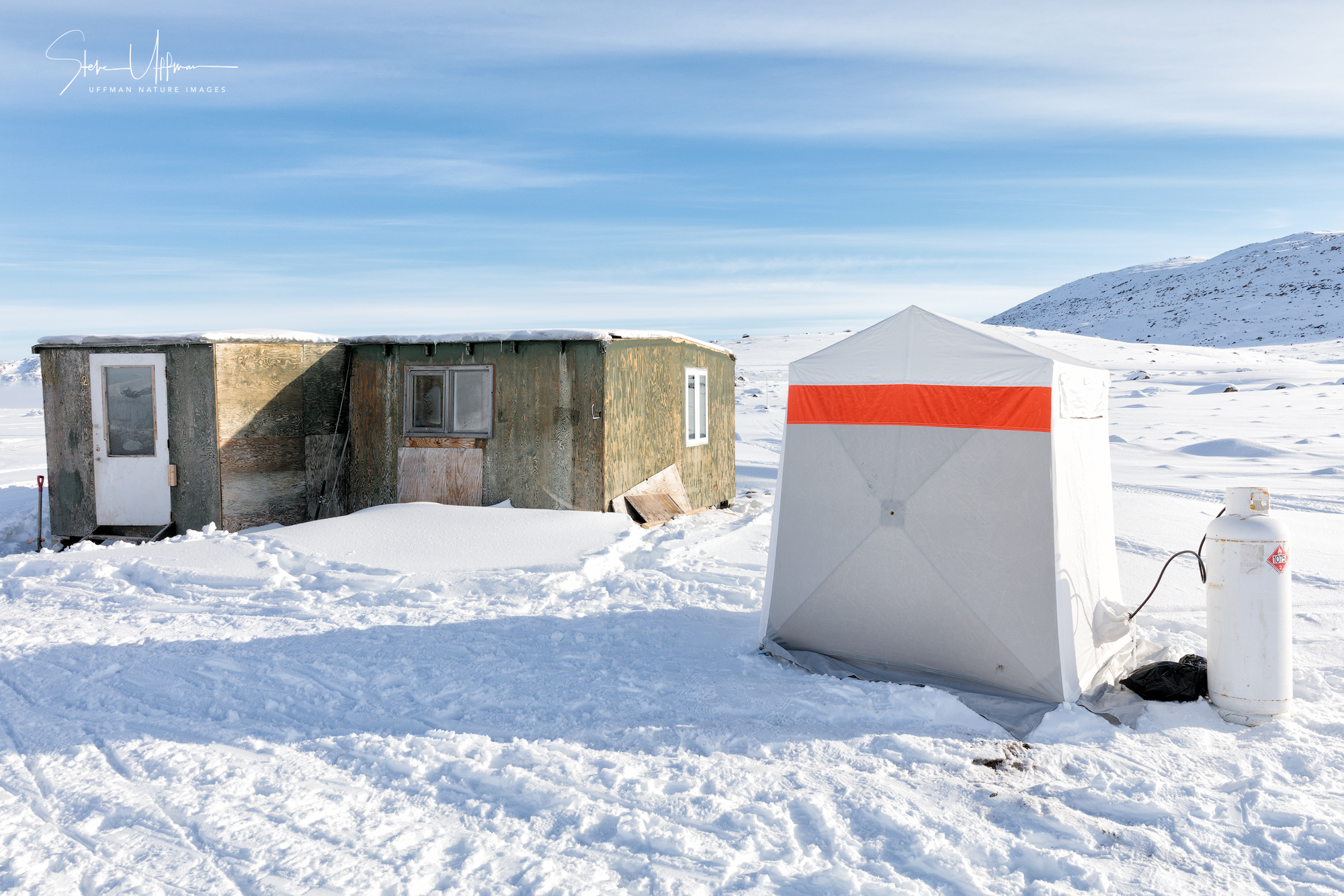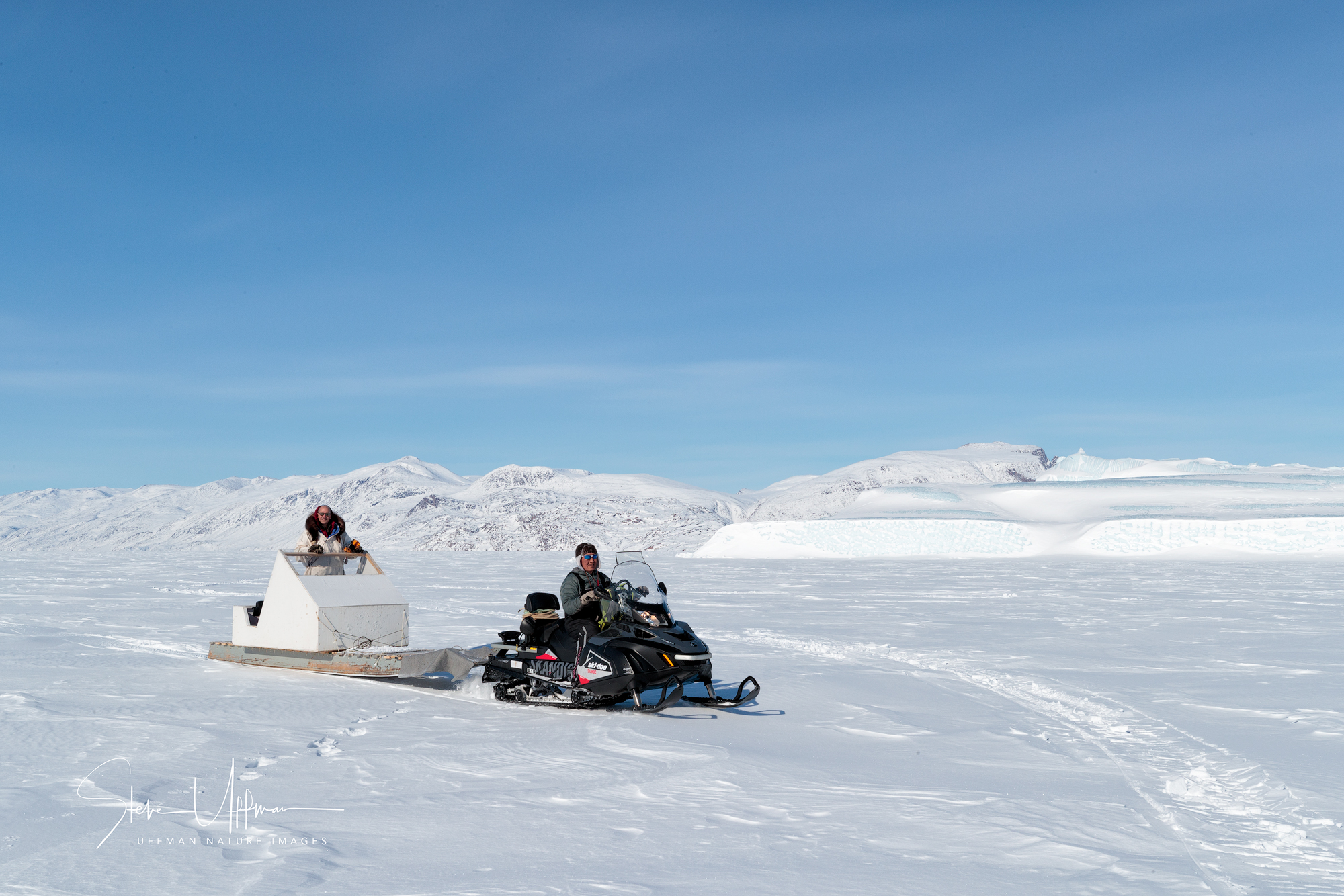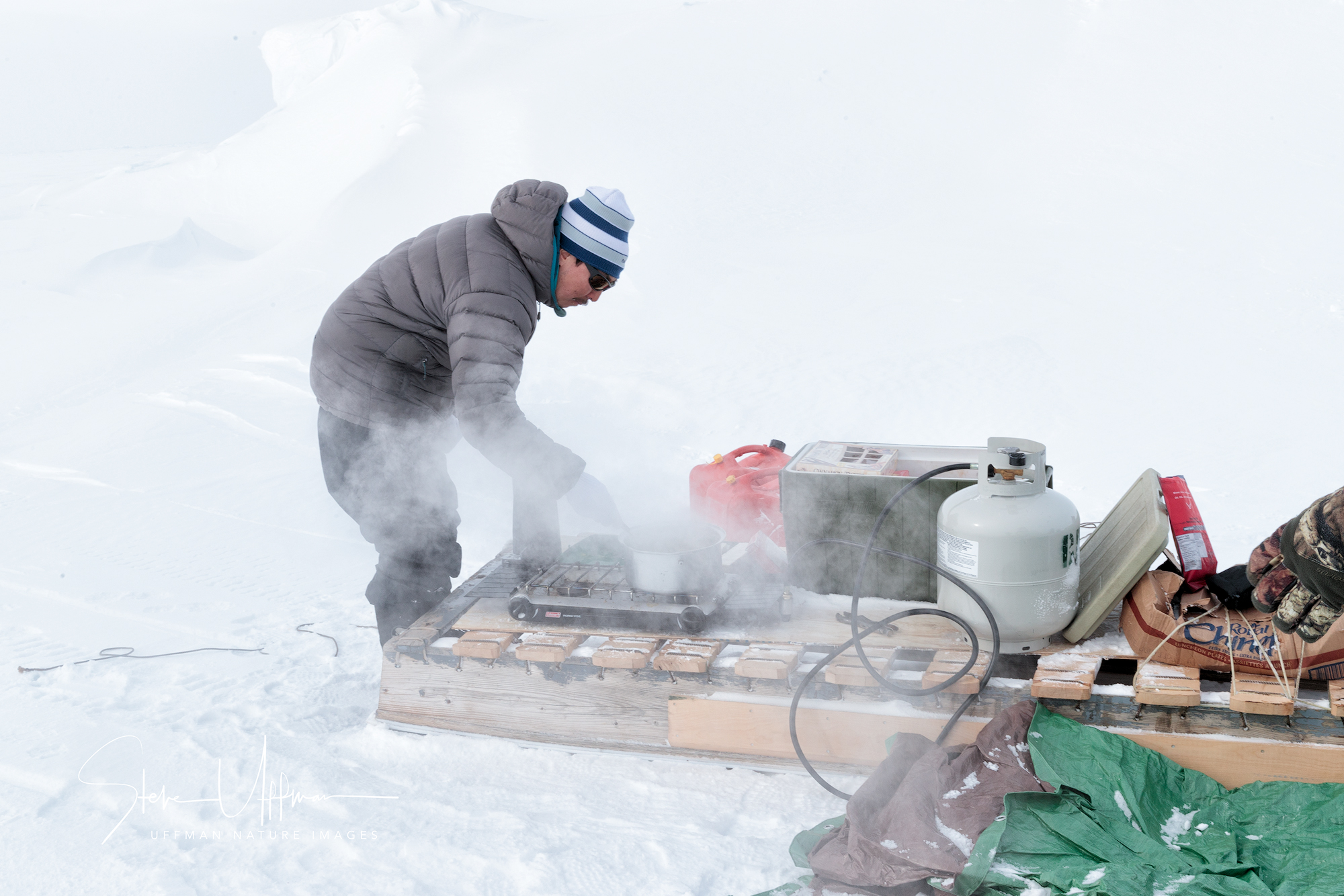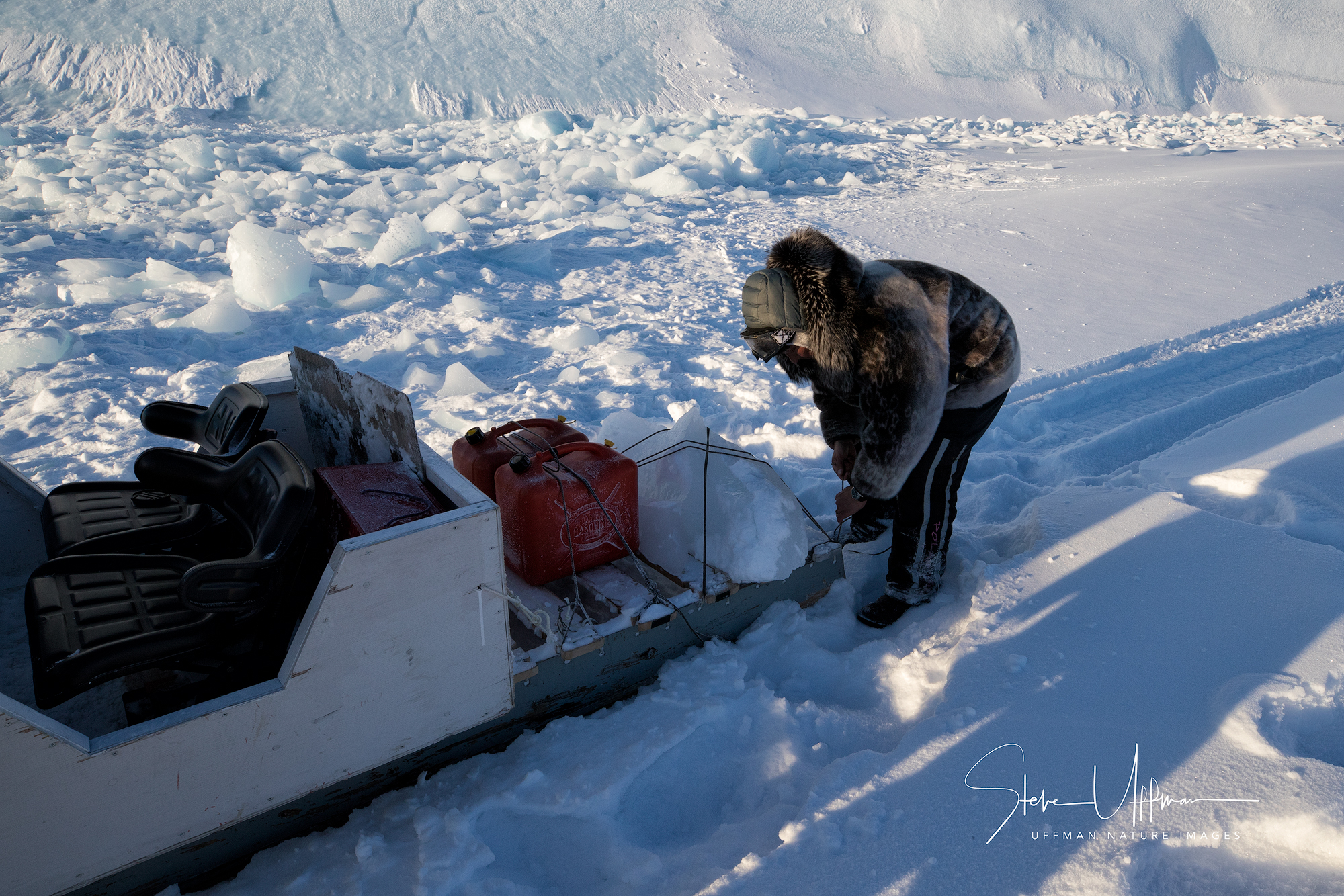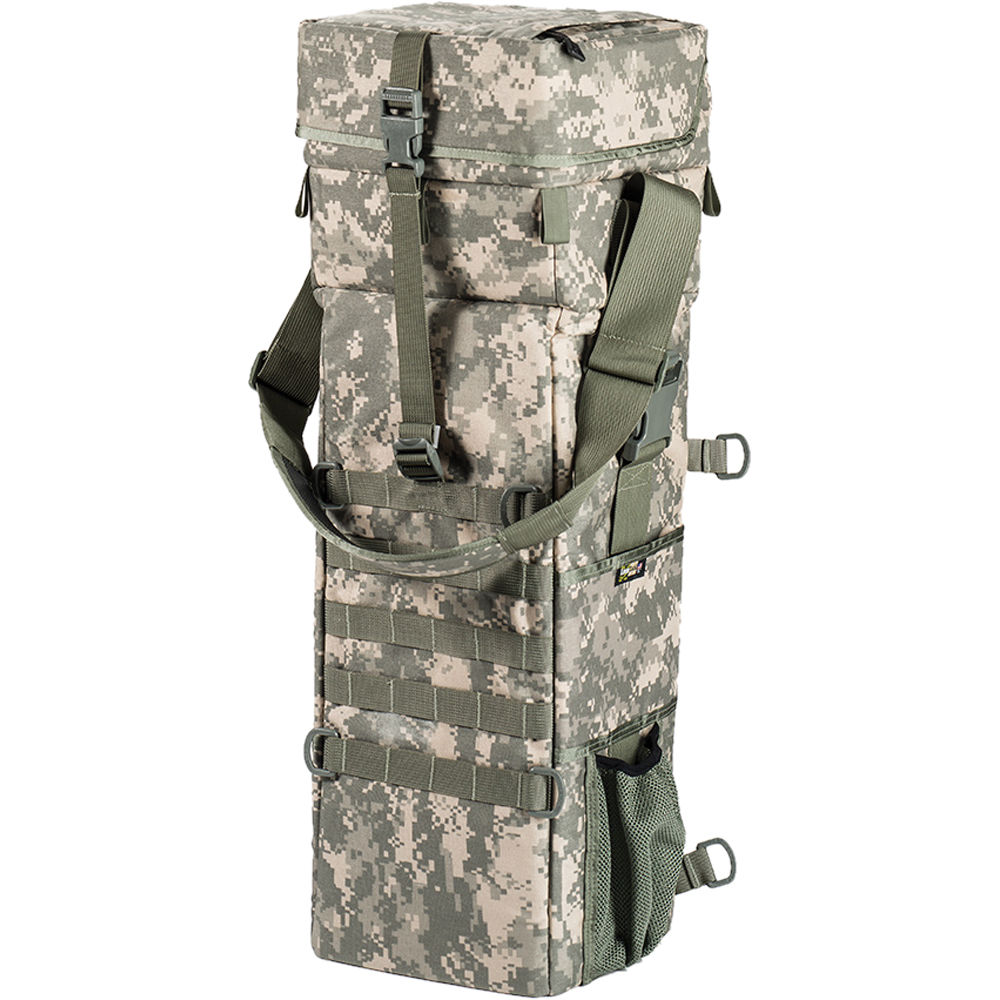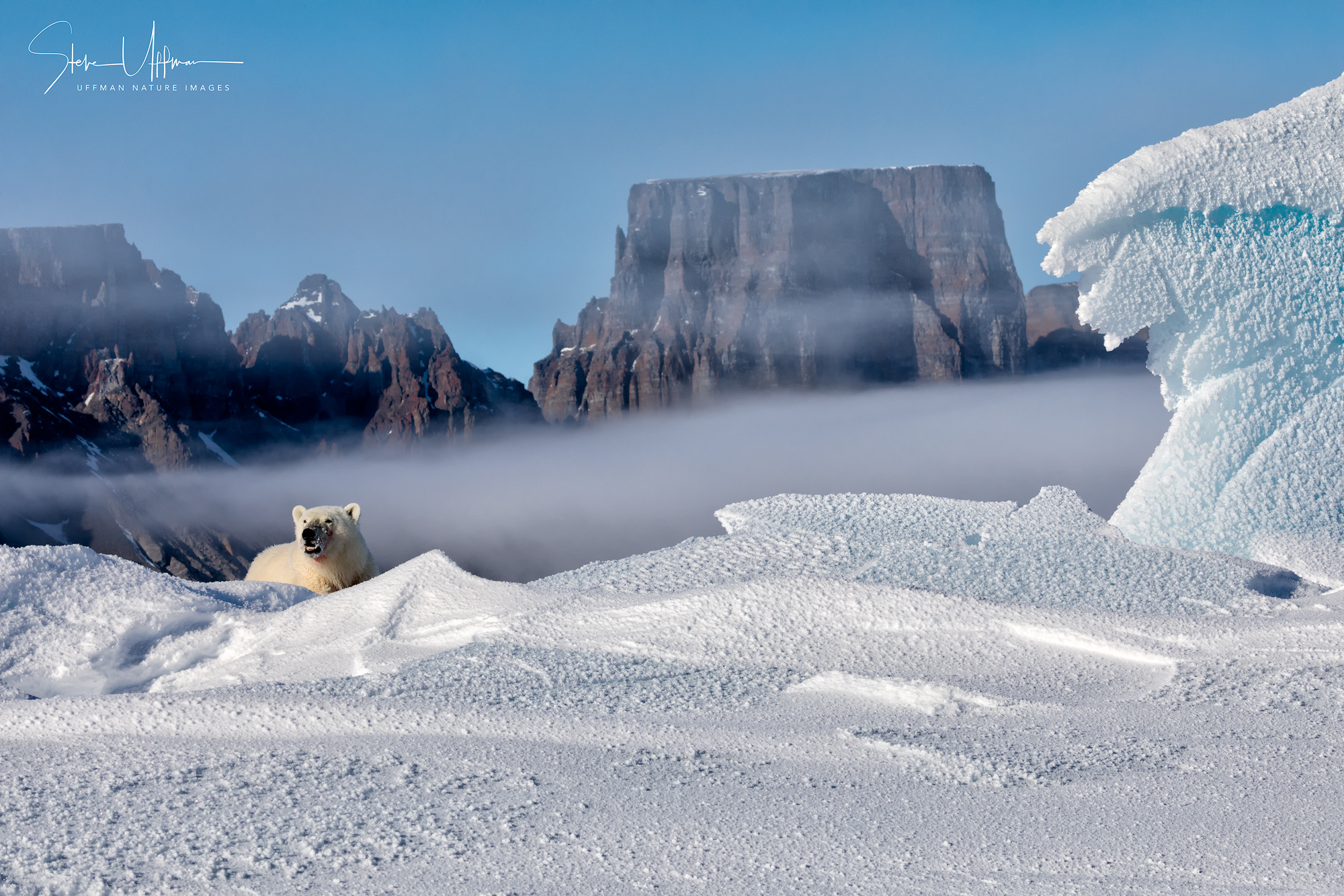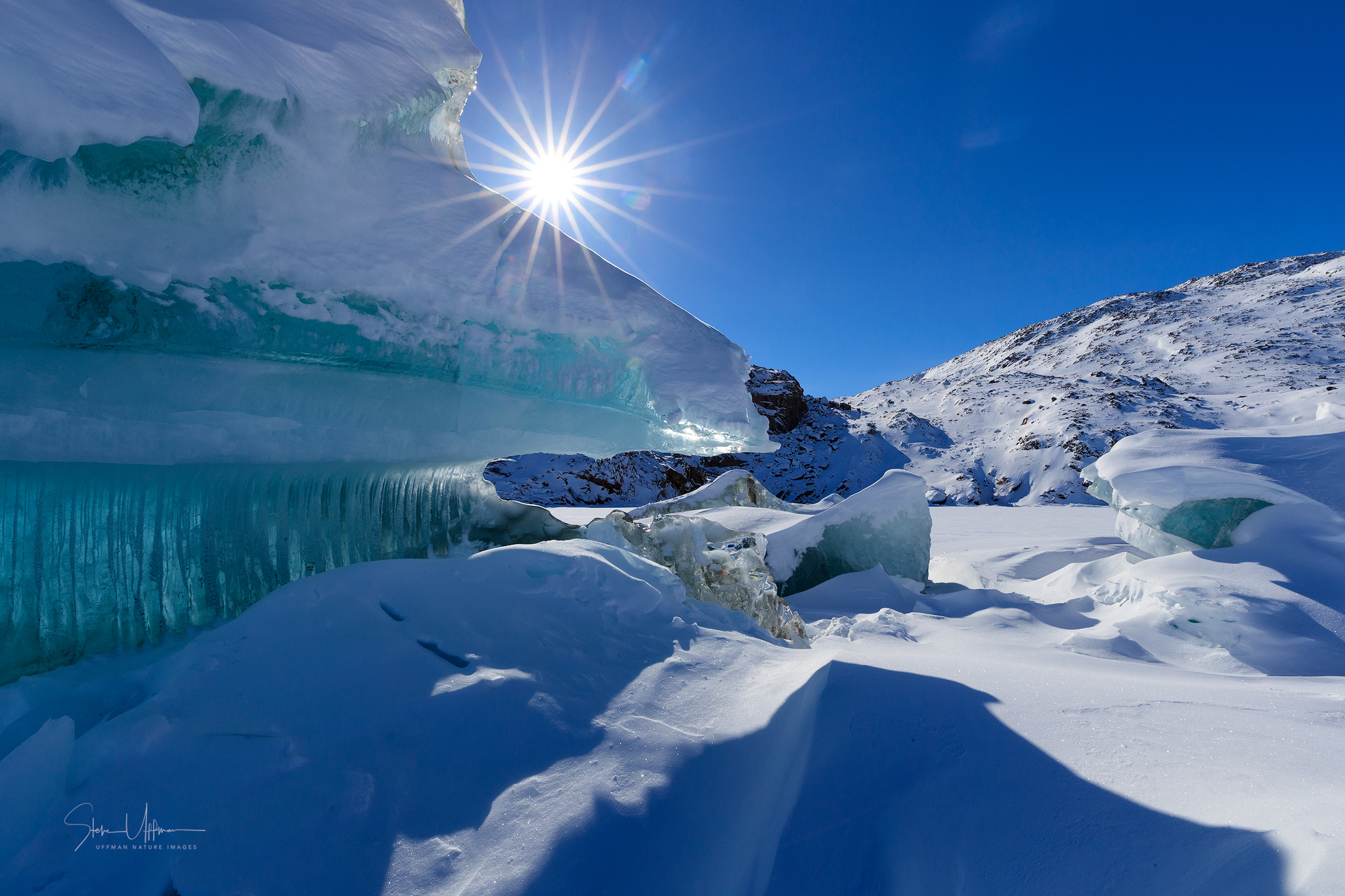Background: We will begin our refresh of our blog with a series of stories and images of our recent trip to the Eastern Arctic. In the series, we will include stories about beautiful landscapes, polar bears, icebergs, glaciers and of course the wonderful Inuit people. We will dig into the risks of being so remote that rescue maybe two days away and more. Certainly an important part of the story is the many logistical challenges of a photographic adventure in an area where temperatures during our time there ranged from 0 to -20F. A good bit to cover that I hope you will enjoy.
I also should introduce my good friend and superb photographer Gari Kitchen who put this trip together at the last minute. On trips like this one, it is important that your party have the right attitude when they attempt such a trip as this one. Gari and I have done a number of photography trips together and this is the 4th for polar bears. We also have gone hard core before when we camped in tents in Halo Bay, Alaska with a goal of finding coastal brown bears with spring cubs. Poured down rain the whole time but we got some fantastic pictures and it was a wonderful experience-one we would have enjoyed even if the cubs didn’t show up. I say this only to help you test your own mindset if you consider a trip like this. I would go back in a heartbeat. It might be my favorite trip of all time. Some of that no doubt is simply letting nature take its course, enjoying the moment and overcoming whatever obstacles come your way.
To kick it off, we will first focus on the location and logistics. The area we wanted to explore is known as the Eastern Arctic. Our point of departure is a hamlet called Qikiqtarjuaq located in Nunavut, Canada-North of the Arctic Circle. “Qik” as it is often referred to is 2800 miles from my doorstep and required 5 flights and two days to get to our outpost. Qik is a very friendly community of 520 (2016) that is 95% Inuit. Two languages are spoken: Inuktitut and English. When not frozen over, many species of marine mammals thrive there, including bowhead whales, narwhals and orca whales. Also walrus can be found nearby during those times. However for our purposes at this time of year, it’s the fact that it is known as the iceberg capital of Nunavut and has a nice population of polar bears that are non habituated to humans. Certainly the beautiful snow covered landscapes heighten the appeal.
Qik is located at the gateway of the great Auyuittuq National Park which is one of the areas we will scout for bears. To do so, we need a permit and upon landing we have a quick meal at the Inns North motel and then go directly to the Parks Canada office for orientation. During the required orientation, safety is heavily emphasized-particularly due to how remote a location we will be traveling. They got my attention pretty quickly when they explained that if we fell into a crevasse, that the resources likely to rescue us would come from Banff or Jasper Alberta-and that we should be prepared to stay in the crevasse for about two days! Wow!
Next, we watched a video regarding polar bear safety. The message was clear that the animals we encountered once we got to our outpost were not in anyway habituated to humans. In fact many might never have encountered a human being so we needed to stay alert. Basic instincts of fight or flight would be likely bear behavior. Of course they then related that our guide Billy was the very best guide and if he wasn’t with us he also would likely be leading the rescue team. That was reassuring.
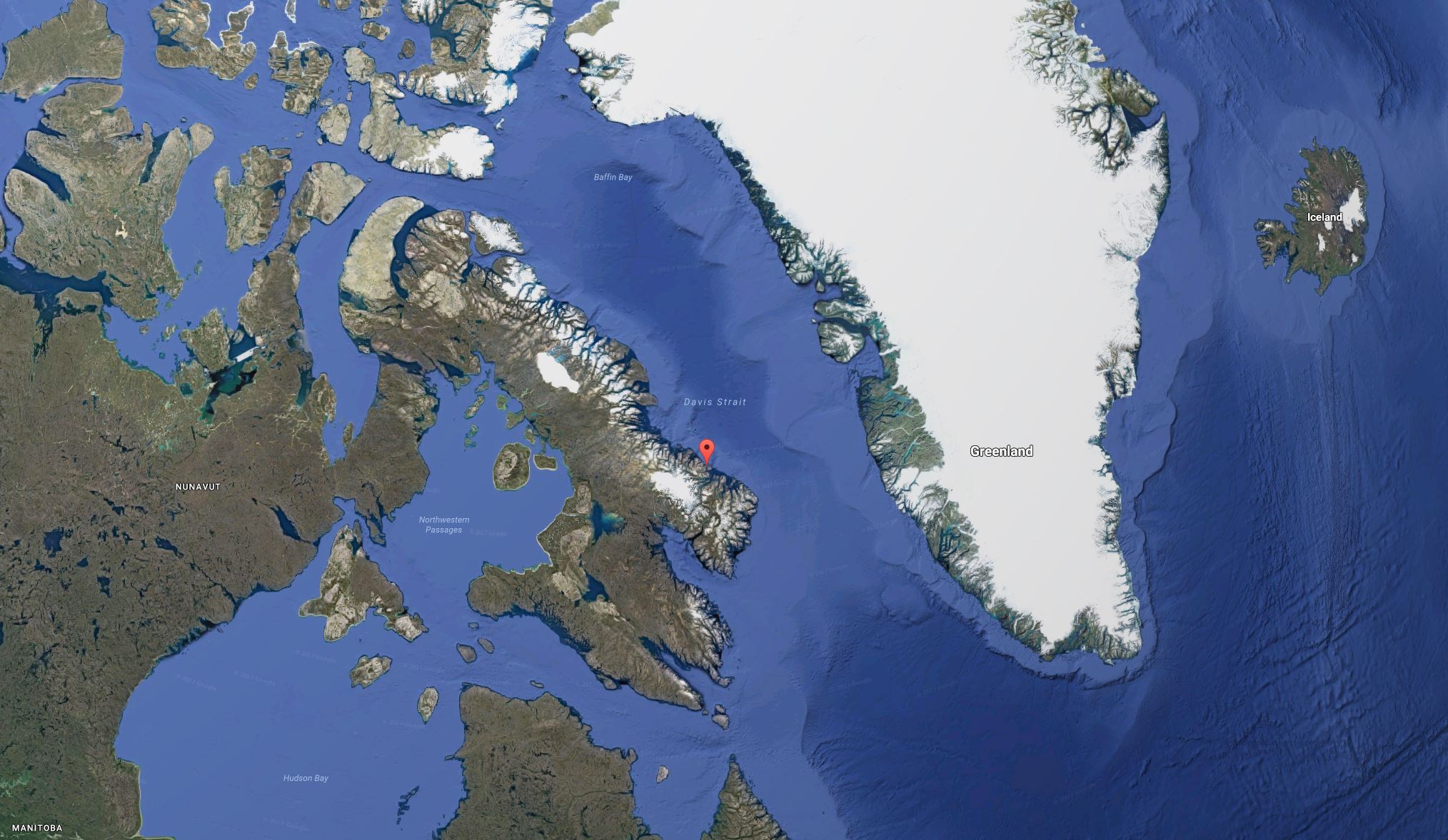
Billy is a senior elder in the community and an absolutely marvelous human being. Not only were we in expert hands, but the time we had to talk about nature, life and importantly Inuit culture was among the many highlights of the trip. Joining Billy was his youngest son Raymond. Raymond would also serve as our cook among his many other duties. I will have more about Billy and Raymond in subsequent blogs. As soon as we completed the briefing, dark was approaching and we still had a 2-3 hour distance to go to get to our outpost. How would we get there? Well in a special sled held together by rope, pulled by a snowmobile of course!
The image below is a daytime view of the type of terrain we traversed to get to our outpost. The frozen fjords served as our highway through the mountains. Along the way of our night time travels, the Northern Lights entertained us with their dance. With nightfall temperatures likely in the -20F range, the windchill was much more as we moved along toward outpost. Beautiful, cold and bumpy as you will see later.

The outpost consisted of three buildings. One in which the guides slept that also was were we would have our morning and evening meals. The second was a cabin belonging to Billy’s father which we did not use. The third structure was our quarters for the week. It is a bit further away from the other two now as strong winds blew it to its current position.
Billy and Raymond are clearly pragmatic people and built the buildings out of leftover materials from shipping crates. The buildings have low ceilings to conserve heat. Doors have to be pulled open so bears can’t push them in. Heat is provided by a simple portable propane heater. There is no plumbing of any sort. Water is obtained by melting blocks of ice that have fallen off icebergs. During the summer, the outpost serves as a camp for their family recreation. They travel here by boat at that time. Fishing is spectacular for arctic char . Billy and Raymond put out gill nets to catch their fish. Billy’s wife and Raymond’s mom Daisy is however the master fisherman they admit. She is patient and uses a handline exclusively. More on the marvelous Mrs. Daisy soon.
For a restroom, we have a tent and a five gallon bucket with a lid and plastic bag. Plywood is put down as a floor and a small propane heater heats the small tent. Plenty workable. Power is supplied to the two buildings with a small Honda generator that is especially equipped to handle extreme cold. The generator is placed midway between the two buildings and an extension cord is run to each. With our multiplugs, we have plenty of power to charge our batteries. One lamp lights our building. Our building has two beds, two sofas and a table plus plenty of places to hang socks and other gear to dry out overnight. The small heater keeps the room at 52F which not only is plenty to dry our boots (that always at day’s end have ice inside from perspiration) and keep us comfortable for sleeping. At home, 52F room temperature would be unthinkable but it actually is very comfortable after a 12 hour day on the ice where temperatures are sub zero. Gari and I are both veterans at camping in harsh conditions in the wild as we pursue our hobby of nature photography so we quickly get into our sleeping bags and rest easily as we dream of the next day’s amazing adventure.
Where we were headed you either went by boat in the summer or as mentioned before by qamutiik pulled by a snowmobile. A qamutiik is the sled pictured earlier and is designed to travel over snow and ice. In our case, it is pulled by snowmobile-but also can be pulled by dogs or humans. For our excursion, we had two qamutiiks each pulled by a snowmobile. Gari and I were in one with our photography equipment. The other carried supplies, cooking gear and more.
The one pulled by Billy had a special structure attached by rope to the sled. It had seats, a windshield and a grab bar for standing as you can see here as Gari and Billy come pick me up from photoing an iceberg. The sled is a product of Inuit ingenuity and is specially adapted for such conditions. The qamutiik does not use nails or pins to hold the runners and cross pieces together. The Inuits drill each board and lash them together with rope to provide flexibility of movement that can survive the pounding of traveling in the frozen land. An engineering marvel really. Each cross piece is notched and they are all lashed together in a continuous lashing using self locking knots. The cross pieces and runners are lashed together and as you can see so is the box that we rode in. History tells of early British and American explorers that tried to use conventional sleds but soon learned what the Inuit knew-that sleds built with nails and screws fell apart from the constant jarring as they ran across the miles of sea ice. We can confirm that jarring does loosen screws. Part of my gimbal head and a couple of the tripod feet came unscrewed the first day. Gari had a tripod leg section detach. No worries though, we mitigated the problem with some padding and all was good for the rest of the trip.
Runners are made of wood with a layer of polyurethane or nylon to reduce drag. I know that one of my concerns is how much gas the snowmobiles would burn pulling us in the sleds around for the next week. The answer is hardly any. The sleds move very easily which we learned later when we got stuck (more on that later).
Gari and I are of the mindset is that if we came to photograph wildlife and nature, that we want to be out in the field-even in subzero temperatures. Billy and Raymond felt the same way so they planned on lunch (and yes snack breaks) out in the field. While some might think a sandwich or power bar, that is not the way Billy and Raymond roll. Whether lunch or just a coffee break, Raymond fired up the Coleman stove and had hot coffee and various hot meals ready to go. Having a bowl of hot soup or stew out on the ice is hard to beat. Add hot coffee and then some of Mrs. Daisy’s Bannock (Inuit fried bread similar to a beignet) and life is good! Also must mention that frozen snickers are really, really, really, really wonderful snacks too!
Earlier, I mentioned that all our water comes from melting ice. Sure you can use snow but it takes a lot of snow to get even a cup of water. We did however melt snow for coffee while out in the field. The bulk of our water came from melting big blocks of ice that had fallen off icebergs or glaciers. Now it is important to know that icebergs are from snow frozen over time and are freshwater. Sea Ice is however frozen saltwater. With both in the area, you are careful which ones you select. Good news is that there are lots of chunks of ice that have fallen off the icebergs. Generally, it is as simple as picking a choice block up and lashing it to the qamutiik. On one occasion however we had a bit of a dicey experience. You see the fjords are very deep and most of the icebergs are floating-even though 90% of the iceberg is below the surface. Even though they are huge, that means they can move and rise and fall with the tide. Even minimal movement can make the ice around the edges slushy. Bears and seals know this and that is why you can often find seal holes around the edges and bears looking for them there. For us however, we found an iceberg that had slush out 6-8 feet from its edge. That was a bit of a surprise as we bogged out snowmobile down in the soft ice. Stepping off the the snowmobile, Billy’s boot sank and a watery slush was visible. Imagine a boot filled with water in sub zero temps with the outpost two hours away. Not good but then not bad if you are experienced. Eager to help get the snowmobile out, we were prepared to jump out. Billy said no and listen to his instructions. Using a pole for both balance and a prod to test the ice, Gari walked over to help Billy detach the qamutiik to make it hopefully easier to get the snowmobile unstuck. While there Billy, with Gari’s help, got the snowmobile moving . Billy then made a big circle to find firm ice and came back to get us. By now Gari and I had both poked the ice around the the gamutiik and it was slushy as well. Nevertheless, we felt we could turn the sled 90 degrees and then attach the sled to a rope that Billy could pull out. Earlier I mentioned that qamutiiks are designed with Inuit ingenuity and the sled was easy to turn (without us getting our boots soaked in the subzero temps). Billy attached the rope and in short order we were on our way.
Of course, you like I are beginning to wonder of the comfort of being pulled in a sled lashed together with rope across ice for hours and hours for the next week. That is a valid question as well as how would our camera gear hold up to vibrations that are severe enough to make a conventional sled fall apart. Perhaps you had a thought about windchill as well. All part of the adventure for us! In a subsequent blog, I will share how we dressed for the cold. As far as equipment being jostled, Gari and I each packed a duffle with all the clothing and such that we were not using and put that under the Lens Coat Xpandable Long Lens bag. That bag worked very well as we could have our camera and lens assembled and ready to go and could pull them out at a moment’s notice. The bag also has a padded collar inside the bad that wraps around the small end of the lens which gives protection for the lens and the camera. Add some socks, long underwear and anything else you can stuff in the bag and at least our camera gear had no issues with all the bouncing around. And I can tell you that having the long lens and camera ready to go in an instant is important when you see a mom hustling her cubs up the side of a mountain! In one instance, Gari and I were both hand holding a 600mm with a 1.4x III multiplier to capture mom and the cubs just before they disappeared behind a rock. Get a high enough shutter speed and you are good to go.
You maybe thinking okay that takes care of the gear, but what about the person with the bad back? I am 66 and Gari is 59. Ironically, while Gari and I both have some back and knee issues normally, neither of us had any problems with our backs, knees or anything else on the trip. Hard to explain. For one thing, Billy has a nice seat that has some suspension in the qamutiik. No doubt that helped a lot. Other than that it seems you bounce in so many directions that it’s almost like therapy!
Of course, part of it is that even though we spent an average of 12 hours a day out on the ice, the beauty is so amazing, the adventure so awesome that adrenaline is constantly pumping. Sooner or later, you know there is going to be a special moment and it all seems worthwhile.
My hope is you enjoyed the first entry in this series. Next up, we will talk about the icebergs, sea ice and glaciers that are so spectacular.
If enjoy this blog, you can signup to get the email notifications when new entries are posted. There is a icon for signup at the end of blog just above the comment section. Also please feel free to share. Word of mouth is really the only way the news gets out. Also, please consider leaving a comment with your thoughts
Thanks again for your interest.
Steve

